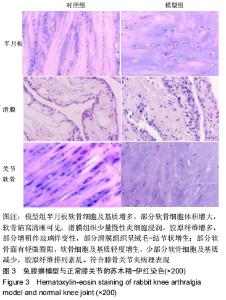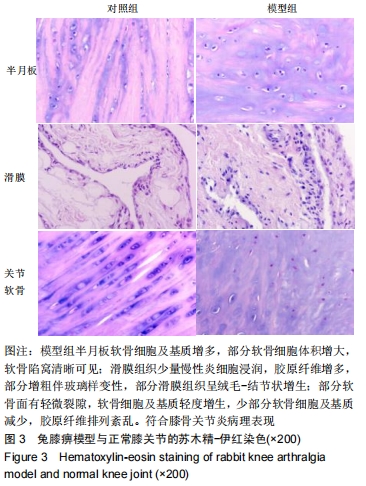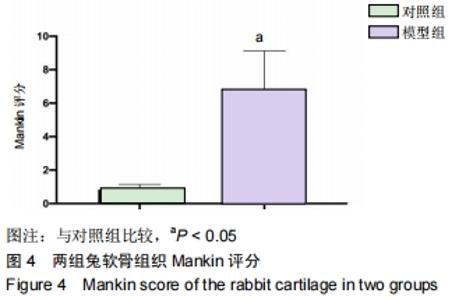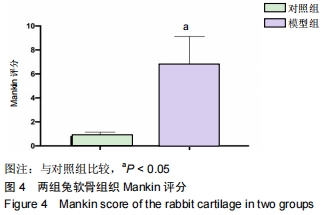[1]王丽颖,赵学尧,宇文亚,等.中医诊疗指南与中医临床路径、中医诊疗方案的比较[J].中医杂志,2015,56(24): 2112-2115.
[2]王宝娟,郑曙光,周玉平,等.探讨不同浓度碘乙酸钠对家兔早期膝关节骨性关节炎模型的诱导及病理改变[J]. 湖南中医药大学学报,2019,39(3):316-319.
[3]张君涛,吴超超,张栋林,等.膝关节骨性关节炎动物模型研究进展[J].重庆医学,2018,47(15): 2061-2063+2067.
[4]摆雪,张洪平,刘俊昌,等.石膏铁丝固定法建立兔膝痹模型[J].中国组织工程研究,2016,20(18): 2603-2608.
[5]檀臻炜,汪丙昂,姚一民,等.兔膝关节力学有限元分析及软骨缺损模型的建立[J].西南国防医药,2018, 28(12): 1213-1217.
[6]马浩哲,熊翼.葛根素治疗膝关节骨性关节炎模型兔的机制[J]. 中医学报,2019 34(5): 1016-1019.
[7]王丽娟,史晓伟,张伟,等.针刀干预对膝骨关节炎兔股四头肌肌腱拉伸力学的影响[J].中国骨伤,2019, 32(5): 462-468.
[8]DING Y, YUAN XL, WANG YC, et al. Acupotomy versus sodium hyaluronate for treatment of knee osteoarthritis in rabbits.J Tradit Chin Med.2017;37(3): 404-411.
[9]詹红生,郑昱新.成人膝关节滑膜炎诊断与临床疗效评价专家共识[J].中国中医骨伤科杂志,2016,24(1): 1-3.
[10]MANKIN HJ, LIPPIELLO L. Biochemical and metabolic abnormalities in articular cartilage from osteo-arthritic human hips.J Bone Joint Surg Am.1970;52(3):424-434.
[11]陈天钢,勾禹,田发明,等.雌激素及选择性雌激素受体调节剂对骨关节炎作用的研究进展[J].中国临床药理学杂志, 2018,34(1): 73-76.
[12]LEE KY,周逸,张俐.去卵巢老年大鼠软骨退变与E2、MMP-13、TNF-α的相关性[J].福建中医药,2018, 49(2): 30-32+38.
[13]陈刚,李箭,付维力,等.单独后交叉韧带断裂伴半月板和软骨损伤及其影响因素[J].中南大学学报(医学版),2015,40(6):674-680.
[14]HULTH A, LINDBERG L, TELHAG H. Experimental osteoarthritis in rabbits.Acta orthopaedica Scandinavica. 1970;41(5): 522-530.
[15]STEINBRUK A, WOICZINSKI M, WEBER P, et al. Posterior cruciate ligament balancing in total knee arthroplasty: a numerical study with a dynamic force controlled knee model. Biomed Eng Online.2014; 1391.
[16]ZHOU X, ZHANG L, GUO XG, et al. A Macaca Fascicularis knee osteoarthritis model developed by modified Hulth combined with joint scratches.Med Sci Monitor.2018; 243393-243404.
[17]肖春苟,邹锦慧,李力强,等.以改良Hulth法建立兔膝骨性关节炎关节软骨的病理变化[J].中国中医骨伤科杂志,2014,22(12): 1-3.
[18]佘国荣,查振刚,汪飞,等.软骨下骨量变化与软骨退变的相关性[J].中国组织工程研究,2015,19(20): 3134-3140.
[19]VIDEMAN T. Experimental osteoarthritis in the rabbit-comparsion of different periods of repeated immobilization.Acta Orthop Scand. 1982;53(3):339-347.
[20]孙银铁,郭开今,蔡红星.NOD2、NLRP3在石膏关节制动法建立兔膝骨性关节炎模型关节软骨中的表达[J].中国组织工程研究, 2018,22(8):1211-1216.
[21]张伟,王彤,王丽娟,等.膝关节炎模型体重与病理形态相关性及针刀干预的实验研究[J].针灸临床杂志, 2018,34(9): 63-68+91.
[22]CARLSON AK, RAWLE RA, WALLACE CW, et al. Characterization of synovial fluid metabolomic phenotypes of cartilage morphological changes associated with osteoarthritis. Osteoarthr Cartilage. 2019;27(8): 1174-1184.
[23]MAZOR M, BEST TM, CESARO A, et al.Osteoarthritis biomarker responses and cartilage adaptation to exercise: a review of animal and human models.Scand J Med Sci Sports. 2019 Aug;29(8):1072-1082.
[24]LU W, WANG L, WO CX, et al.Ketamine attenuates osteoarthritis of the knee via modulation of inflammatory responses in a rabbit model.Mol Med Rep. 2016;13(6): 5013-5020.
[25]PRICE CC, TANNER JJ, SCHMALFUSS I, et al.A Pilot Study Evaluating Presurgery Neuroanatomical Biomarkers for Postoperative Cognitive Decline after Total Knee Arthroplasty in Older Adults. Anesthesiology.2014;120(3): 601-613.
[26]ZHOU Q, WEI B, LIU S, et al.Cartilage matrix changes in contralateral mobile knees in a rabbit model of osteoarthritis induced by immobilization.BMC Musculoskelet Disord. 2015; 16:224.
[27]卢向阳,唐芳,马武开,等.骨关节炎动物模型的研究进展[J].风湿病与关节炎,2017,6(2): 63-67+75.
[28]马永圆,郭海云,白福海,等.电针治疗膝骨关节炎的基础研究进展[J].上海针灸杂志,2018,37(7): 833-840.
[29]戴七一,谢智光,黎强,等.揉髌手法对兔膝关节骨关节病模型血液流变学的影响[J].中华中医药杂志, 2016;31(2): 604-607.
[30]MUNROE M, DVORETSKIY S, LOPEZ A, et al. Pericyte transplantation improves skeletal muscle recovery following hindlimb immobilization.FASEB J. 2019;33(6):7694-7706.
[31]ZENG DX, LUO QL, LIN HD, et al. The effect of therapeutic ultrasound to apoptosis of chondrocyte and caspase-3 and caspase-8 expression in rabbit surgery-induced model of knee osteoarthritis. Rheumatol Int. 2012;32(12):3771-3777.
[32]袁望舒,陈丽霞,金光,等.负重游泳运动对膝关节骨性关节炎大鼠关节软骨及运动能力的影响[J].中国康复医学杂志,2014,29(1): 14-19.
[33]陈志达,林瀚洋,余志毅,等.膝骨关节炎动物模型研究进展[J].风湿病与关节炎,2016,5(1): 67-70.
[34]RAMAKRISHNAN P, HECHT BA, PEDERSEN DR, et al. Oxidant conditioning protects cartilage from mechanically induced damage.J Orthop Res. 2010;28(7):914-920.
|



